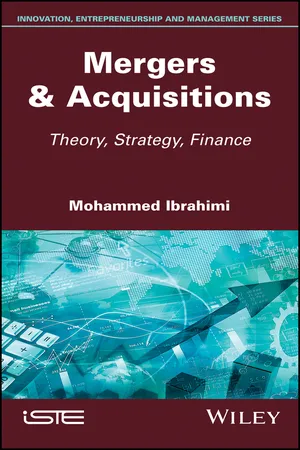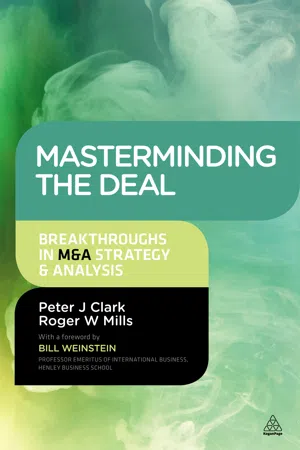Business
Merger Waves
Merger waves refer to periods of increased merger and acquisition activity within an industry or across the entire economy. These waves are characterized by a surge in the number and size of mergers, often driven by factors such as economic conditions, technological advancements, or changes in regulatory environment. Merger waves can have significant impacts on market structure, competition, and corporate strategies.
Written by Perlego with AI-assistance
Related key terms
Related key terms
1 of 4
Related key terms
1 of 3
4 Key excerpts on "Merger Waves"
- eBook - ePub
Mergers & Acquisitions
Theory, Strategy, Finance
- Mohammed Ibrahimi(Author)
- 2018(Publication Date)
- Wiley-ISTE(Publisher)
3.1. Merger/acquisition wavesThe wave phenomenon in mergers and acquisitions is one of the fundamental issues in corporate finance. A wave consists of a sudden and massive upsurge in the number of operations, concentrated within a specific period. Economic history is marked by global macro-waves of acquisitions. These waves have contributed significantly to the evolution of managerial thought in reaction to the phenomenon, particularly in the US; in France, research in this area developed much later, concentrated in the last few decades.3.1.1. Global market and merger/acquisition waves3.1.1.1. Merger/acquisition waves from 1990–2016Finkelstein and Cooper [FIN 09] note that international literature on mergers and acquisitions is, to a certain degree, fragmented. The sums involved, however, have reached phenomenal heights. In 2016, for example, 47,000 operations took place, with a total value in excess of 3,100 billion euros. The evolution of the phenomenon from 1990 to 2016 is shown below.Number and value of mergers/acquisitions worldwideFigure 3.1.(Source: Thomson One Banker)Figure 3.1 . shows three waves of international mergers and acquisitions:- – 1999–2000: record years in terms of the sums involved. The total for these operations increased by 53% between 1998 and 1999 to over 3,900 billion euros, a sum which had never been attained in previous years, and which was not seen again until 2015. This development was supported by the dot-com bubble and the emergence of new technologies.
- – 2006–2007: the end of the period preceding the financial crisis which began in late 2007. At this point, the sum of worldwide mergers and acquisitions reached 3,600 billion euros and in excess of 47,000 operations. This wave affected all sectors: primary, secondary and tertiary. However, it was most significant in the areas of finance and real estate.
- – 2014–2015: figures for 2015 showed a 42% increase on the previous year. The value of merger and acquisition operations reached an unprecedented 4,271 billion euros. This development was supported by the Asian markets, consolidating the 2014 increase, following the drop-off after the 2008 financial crisis.
- eBook - ePub
Cross-Border Mergers and Acquisitions
UK Dimensions
- Moshfique Uddin, Agyenim Boateng(Authors)
- 2014(Publication Date)
- Routledge(Publisher)
In an attempt to explain the causes of Merger Waves, Gort (1969) developed the economic disturbance theory of Merger Waves. According to this model, Merger Waves are caused by economic disturbances which create disequilibrium in the product markets. Simply put, economic disturbances cause changes in individual expectation and increase the general level of uncertainty. Thus, the economic disturbances change the ordering of individual expectations in that previous non-owners of assets now place a higher value on these assets than their owners and the converse is true (Trautwein, 1990). The result is a merger wave. Gort’s model appears in line with the occurrence of Merger Waves during the economic growth worldwide. For example, the merger wave from 1916 to 1929 was due to the worldwide economic boom in the post–World War I period and the lenient securities law at that time. The stock market crash in 1929 put an end to this second merger wave. It is important to point out that although economic disturbance may partly explain the wave behaviour, the causes of waves may come from a wider range of influences including political and technological factors (Sudarsanam, 2003). UNCTAD (2000) and Kang and Johansson (2000) pointed out that the spectacular growth in CBM&A activities in 1990s was mainly due to various technology and government related factors. Rapid technological changes in the 1990s and increased liberalization of international capital movements and deregulations in several economic sectors have motivated business enterprises to form partnerships through friendly deals to achieve common business interests. Kang and Johansson have pointed out that technological change has different types of effects in stimulating CBM&A. First, improvement in communication technology has helped to reduce communication and transport costs that have favoured international expansion of firms. Second, new information technology has also helped managers to exercise flexible management techniques in an efficient manner in the international arena. Third, technological change has shortened the product life cycle. This in turn has increased the uncertainty related to technology intensive products and increased R&D costs to find new alternatives. To cope with the uncertainty arising from technological advancements and increased R&D expenditures, firms are forced to form various unions and strategic alliances that have increased the global CBM&A activities. The surge in CBM&A in the service sector in the 1990s was mainly contributed by technological advancements in the telecommunications and media and information industries. A notable extension of technological innovation to explain merger wave come from Jovanovic and Rousseau (2002), who suggested that well-managed companies with high Qs increase their merger activity and lead the merger wave. According to Gugler et al. (2012), a major technological advance increases the profitability of investment and leads to an increase in many companies’ Tobin’s Qs. These increases in Qs generate a stock market boom and merger wave. Major technological changes affect all companies in an economy, not just those listed on stock exchanges. If the rising stock prices reflect an increased potential for making profitable acquisitions due to common underlying technological factors, then all firms, not just listed firms, will engage in M&A activities. For example, the late 1990s’ stock market boom was a result of innovations in information technology that also led to increased opportunities for profitable mergers. - eBook - ePub
The Art of Capital Restructuring
Creating Shareholder Value through Mergers and Acquisitions
- H. Kent Baker, Halil Kiymaz(Authors)
- 2011(Publication Date)
- Wiley(Publisher)
Answers to End-of-Chapter Discussion Questions CHAPTER 2 Merger Waves 1. Motives for individual mergers include agency-related and hubris-driven motives as well as efficiency and market power/collusion–based motives. Agency and hubris–driven mergers should result in wealth losses for bidding shareholders and, due to the lack of synergies, would not create value overall. If the wealth loss from bidder shareholders is purely transferred to target shareholders, the combined net value creation would be zero. If the merger involves additional costs, the net value creation could be negative. More efficiency-based reasons include economies of scale and/or scope and the possibility of creating market (pricing) power through horizontal merger in a concentrated industry. In these cases, the combined net value creation is positive, but the premium paid determines how much of it bidder shareholders capture (resulting in positive bidder announcement return). 2. Some behavioral hypotheses are market driven, such as Shleifer and Vishny (2003), where overvalued equity directly leads managers to use equity as currency to acquire the real assets of targets. In others, the high valuation creates uncertainty for target managers as to whether the premium represents true synergies or misvaluation. In the neoclassical view, the rising stock market reflects aggregate economic activity as well as capital liquidity, both of which contribute to increasing merger activity. Thus, rising stock prices do not cause the merger activity but reflect the same underlying forces that cause the activity. 3. There are many ways to use international data to examine the causes of Merger Waves. First, using international data would potentially be a good test of the behavioral hypotheses in the following way - eBook - ePub
Masterminding the Deal
Breakthroughs in M&A Strategy and Analysis
- Peter Clark, Roger Mills(Authors)
- 2013(Publication Date)
- Kogan Page(Publisher)
Destructive strength of the individual tsunami is in direct proportion to the combination of conditions occurring at the wave’s earthquake epicenter. The particular combination of conditions and characteristics – strength of the earthquake shock, depth of the epicenter and the ocean in the immediate area of the shock – all influence how powerful the wall of water becomes, and how far the wave travels.Confronting the notion that merger wave 4 could end before 2019 is the unprecedented combination of origin (epicenter) factors that have sustained past merger booms. Typically only two or three of the factors identified in Figure 1.6 are in place. At the time of writing, all six appear to be in place for the merger megaboom, suggesting a duration comparable to that of the first post-1980 wave (LBO): eight years.FIGURE 1.6 A perfect merger storm: dot com II/merger megaboomThe cash hoard alone (point 1 in Figure 1.6 ) may be sufficient to ensure that wave 4 lasts to 2019. Company cash hoarding persists, even as the recovery gains momentum: as of May 6 2011, Bloomberg estimated that 3,000 of the largest public companies still had approximately $4.8 trillion in cash and short-term investments in their coffers.27Private equity firms – often the earliest to act as the new merger wave starts and the last to leave – sat on $940 billion in unspent capital as of October 2011. Much of this ‘dry powder’ will end up being deployed in buyout transactions as the present wave progresses. As Bloomberg’s Chassany reports: ‘About 41 per cent of dry powder is held by leveraged-buyout funds, according to UK research firm Preqin. LBO funds raised in 2008 have about $91.5 billion in unspent commitments.’281.4 Merger wave issue I: (T)APP-synergy divergence as the wave progresses(See also Appendix A .)Both overall share price indices and APP amounts and percentages required to close deals normally rise over the course of the business-merger wave. Phase I begins modestly, with APP percentages typically in a 10–15 per cent range. The list of available target companies at that point in the cycle is dominated by emergency divestitures from the last collapsed cycle, and solid but unsexy companies from cyclical industries, then at their nadir.
Index pages curate the most relevant extracts from our library of academic textbooks. They’ve been created using an in-house natural language model (NLM), each adding context and meaning to key research topics.
Explore more topic indexes
Explore more topic indexes
1 of 6
Explore more topic indexes
1 of 4



